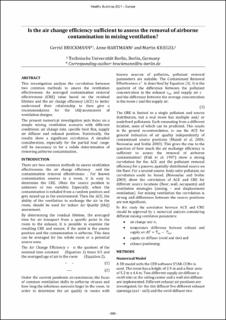| dc.contributor.author | Brockmann, Gerrid | |
| dc.contributor.author | Hartmann, Anne | |
| dc.contributor.author | Kriegel, Martin | |
| dc.date.accessioned | 2022-01-31T17:57:51Z | |
| dc.date.available | 2022-01-31T17:57:51Z | |
| dc.date.issued | 2021 | |
| dc.identifier.isbn | 978-82-536-1728-2 | |
| dc.identifier.issn | 2387-4295 | |
| dc.identifier.uri | https://hdl.handle.net/11250/2976123 | |
| dc.description.abstract | This investigation analyze the correlation between two common methods to assess the ventilation effectiveness: An averaged contamination removal effectiveness (CRE) value based on the residual lifetime and the air change efficiency (ACE) to better understand their relationship to then give a recommendation for the IAQ-assessment of ventilation designs. The present numerical investigation puts focus on a simple mixing ventilation scenario with different conditions: air change rate, specific heat flux, supply air diffuser and exhaust position. Statistically, the results show a significant correlation. A detailed consideration, especially for the partial load range, will be necessary to for a valide determination of removing airborne contamination | |
| dc.language.iso | eng | |
| dc.publisher | SINTEF Academic Press | |
| dc.relation.ispartof | Healthy Buildings 2021 – Europe. Proceedings of the 17th International Healthy Buildings Conference 21–23 June 2021 | |
| dc.relation.ispartofseries | SINTEF Proceedings;9 | |
| dc.rights | CC BY 4.0 | |
| dc.rights.uri | https://creativecommons.org/licenses/by/4.0/ | |
| dc.title | Is the air change efficiency sufficient to assess the removal of airborne contamination in mixing ventilation? | |
| dc.type | Chapter | |
| dc.type | Peer reviewed | |
| dc.type | Conference object | |
| dc.description.version | publishedVersion | |
| dc.rights.holder | © 2021 The Authors. Published by SINTEF Academic Press. | |
| dc.subject.nsi | VDP::Teknologi: 500 | |

